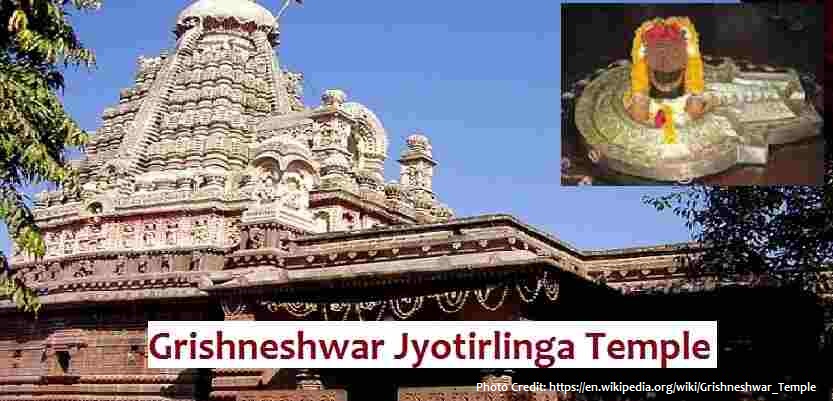Grishneshwar Jyotirlinga temple is one of the dwadasha jyotirlinga temples in India. It is also called ‘Ghushmeshwar Temple’. Grishneshwar temple is dedicated to Lord Shiva and worshipped in the form of lingam. The word Grishneshwar means ‘lord of compassion.
About Grishneshwar temple
Grishneshwar temple is one of the twelve jyotirlingas dedicated to Lord Shiva, located in Verul, near Aurangabad in the state of Maharashtra, India. The meaning of ‘Ghrishneshwara’ is ‘lord of compassion. The significance of this temple is that the devotees can touch the Shiva linga with bare hands.
Grishneshwar Jyotirlinga temple is considered the smallest and last of the twelve jyotirlingas in the country. It is located about 1 km from the famed Ellora Caves. It is a famous pilgrimage site visited daily by many visitors.
What is Jyotirlinga
Grishneshwar Jyotirlinga temple is one of the 12 jyotirlingas in India, where it is believed that the supreme deity of Hinduism, Lord Shiva himself resides in different manifestations in the form of linga. Jyotirlinga means a column of light. Lingam signifies the infinite nature of Lord Shiva, without the beginning and the end. According to ancient scripture, Shiva Puran and Nandi Puran, Lord Shiva will have a presence all over the space. However, his presence will be felt more in these jyotirlingas. In all these places, Lord Shiva is worshipped in the form of Lingam.
Read more on Jyotirlinga and legends
History of Grishneshwar Jyotirlinga Temple
It has gone through several times of construction and destruction processes in its lifetime. During the Maratha-Mughal conflict, the Delhi sultanate had destroyed the temple structure in the 13th and 14th centuries.
Maloji Bhosale, the grandfather of Maratha King Shivaji Maharaj, rebuilt the temple in the 16th century. Again Mughals destroyed the temple. Finally, after the fall of the Mughal empire, it was rebuilt in its current form under the sponsorship of Queen Ahilyabai Holkar of Indore.
Architecture Grishneshwar Temple
The ghrishneshwar temple is built in Maratha-style temple architecture. Red rocks have been used in the construction of the temple and it is comprised of five-tier shikhara. The pillars and walls of the temple are adorned with carvings and sculptures of Gods and Goddesses.
There is a hall in front of the sanctum built on pillars with beautiful ca7rvings in it. There is a statue of Nandi in the court hall. There are exquisite carvings of Dashavatar of Lord Vishnu sculpt in red stone outside.
Legend behind Grishneshwar Jyotirlinga temple
According to mythology, Shiva and Parvati once lived in Kamyakavana. Once when Parvati mixed kunkuma and saffron on her palm with water and rubbed it with fingers, a bright shivalinga appeared. Hence, this full Jyotirlinga was named ‘Kunkumeshwara’. As it was formed because of the friction (ghrishna) between finger and palm, it is also called ‘Ghrishneshwara’.
According to another story mentioned in Shiva Purana, there was a Brahmin called Brahmavetta, who lived with his wife Sudeha on a hill called Devagiri. They were very sad because they had no children. Therefore, frustrated sudeha persuaded her sister Ghushma to marry her husband. Ghushma was a great Shiva devotee. She used to make and worship 101 lingams and discharge them in the nearby lake. After a while, she gave birth to a male child. Over time, Sudeha started feeling jealous of her sister. Out of Jealousy, she killed the boy at night and threw him into the lake. However, the next morning, Ghushma, as a usual practice, worshipped Lord Shiva, leaving everything to him. While discharging the lingams, surprisingly her son emerged from the lake and Lord Shiva appeared. Pleased with her devotion, Lord Shiva gave her a boon. She requested him for staying there eternally for the benefit of the people. On her request, Lord Shiva manifested himself in the form of jyotirlinga and assumed the name Ghushmeshwar.
Grishneshwar Temple Timings
- Darshan Timing - 5:30 AM to 9:00 PM
- Entry Fee - Free
- Special Poojas - Rudrabhishek
- Festivals - Maha Shivaratri, Shravan Month
How to reach Ghrishneshwar temple
Ghrisheshwar temple is located at a distance of 30 km from Aurangabad, 258 km from Pune, and 337 km from Mumbai.
By Air - The nearest airport is at Aurangabad. There are regular flights from other Indian cities.
By Train - The nearest railway station is at Aurangabad. It is again well connected with other cities.
By Road - Aurangabad City Bus station is at a distance of 30 km from the temple. There are frequent buses available from the city. Taxi/Cabs are also available.
Places to Visit near Grishneshwar Temple
Ellora Caves
Ellora Caves, A UNESCO World Heritage site, is the largest rock-cut monastery temple complex, featuring Hindu, Buddhist, and Jain monuments. Located in the Charanandri Hills, the artwork in the temples is believed to be carved from the period between 600-1000 CE. There are over 100 caves at the site, out of which 34 are open to the public. Cave 16, called Kailasa temple, a chariot-shaped monument inspired by Mount Kailasha is dedicated to Lord Shiva. Hindu and Buddhist caves were built during the Rashtrakuta dynasty and Jain caves were built during the Yadava dynasty. Ellora caves are located at a distance of only 1 km from the temple.
